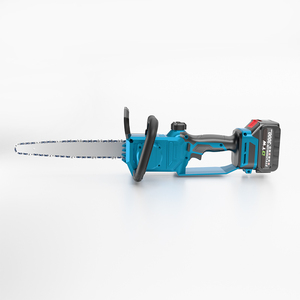
All categories
Featured selections
Trade Assurance
Buyer Central
Help Center
Get the app
Become a supplier

(6840 products available)













































The battery chain saw machine has revolutionized the way professionals and DIY enthusiasts approach cutting tasks. This versatile tool is designed to handle a variety of materials, from wood to metal, with precision and efficiency. Unlike traditional gas-powered models, battery-operated chain saw machines offer cordless convenience, making them ideal for remote or hard-to-reach areas. With features like anti-slip handles, height-adjustable grips, and ergonomic designs, these tools cater to both comfort and performance.
For those new to this technology, understanding the key attributes can help narrow down the best options. Common specifications include bar lengths ranging from 6 to 18 inches, no-load chain speeds between 6.8 m/s and 4500 RPM, and lithium-ion batteries with voltages such as 20V, 24V, or even 42V. Whether you're looking for a lightweight model for trimming branches or a heavy-duty industrial-grade machine for construction projects, identifying your needs will guide you toward the right choice. Consider factors like application type (e.g., woodcutting, metal cutting), grade level (DIY vs. professional), and power source compatibility when selecting your device.
Battery chain saw machines come in several variations tailored to specific applications. Below is an analysis of three primary types based on their functions:
| Type | Bar Length Range | No-Load Speed | Ideal Use Case |
|---|---|---|---|
| Wood-Cutting | 6" - 18" | 6.8 m/s - 4500 RPM | Timber harvesting, pruning, firewood preparation |
| Metal-Cutting | 8" - 16" | 3000 - 4600 RPM | Steel beams, structural metalwork |
| Specialty | Varies by task | Task-specific | Ice blocks, stone sculptures |
Each type offers distinct advantages depending on user needs. While wood-cutting saws prioritize versatility and ease of use, metal-cutting variants emphasize toughness and precision. Specialty saws, though less common, provide unmatched flexibility for unique tasks.
The design and build quality of a battery chain saw machine significantly influence its performance and usability. Manufacturers often prioritize lightweight yet durable materials to enhance maneuverability without compromising strength. Common components include:
Weight distribution plays a crucial role in user experience. A typical battery-operated chain saw weighs between 3 to 5 kg, including the battery pack. Ergonomic enhancements such as anti-vibration systems and adjustable handles reduce fatigue during prolonged use. Understanding these elements helps users select tools aligned with their physical capabilities and project demands.
To illustrate the practicality of a battery chain saw machine, let’s explore two relatable scenarios:
Condition: A farmer needs to clear dense vegetation to prepare land for planting crops.
Conflict: Traditional tools lack the speed and efficiency required for large-scale clearing.
Solution:
Condition: Rescue teams need to clear debris after an earthquake.
Conflict: Lack of access to power sources hinders traditional equipment usage.
Solution:
These examples highlight how choosing the right tool and following best practices ensures safe and effective outcomes.
Proper care extends the lifespan of your battery chain saw machine. Here’s a detailed maintenance checklist:
By adhering to these practices, users can maximize their investment while ensuring consistent performance over time.
Safety remains paramount when operating a battery chain saw machine. Key considerations include:
Adhering to these guidelines protects users from potential injuries and promotes responsible tool handling.
Modern battery chain saw machines offer extensive customization options. Users can personalize aspects such as color, handle design, and replaceable parts. Additionally, pairing accessories like carrying cases, extra batteries, and specialized chains enhances versatility. For instance, brushless motors improve efficiency for demanding tasks, while ODM/OEM services allow businesses to tailor products to specific client needs.
A1. While not designed specifically for bone cutting, certain models equipped with fine-toothed chains may handle softer materials like meat or smaller bones. However, dedicated electric bone saw machines are better suited for this purpose.
A2. Ingco chainsaws are known for their affordability and reliability, offering robust performance across various applications.
A3. Yes, manufacturers increasingly focus on sustainable materials and energy-efficient designs, aligning with growing environmental concerns.
A4. Dewalt drills emphasize precision and power for drilling tasks, whereas Stihl chainsaws prioritize cutting efficiency and ruggedness for outdoor use.
A5. Emerging trends include wireless connectivity for diagnostics, modular designs for easy upgrades, and advanced battery technologies for extended runtime.